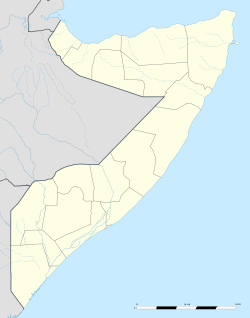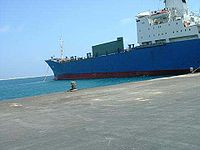
Berbera
Did you know...
SOS Children, an education charity, organised this selection. Child sponsorship helps children one by one http://www.sponsor-a-child.org.uk/.
| Berbera Barbara بربرة |
|
|---|---|
|
|
|
| Coordinates: 10°26′N 45°01′E | |
| Country | |
| Region | Woqooyi Galbeed |
| Population | |
| • Total | 200,000 |
| • Density | 10/sq mi (5/km2) |
| Time zone | East Africa Time ( UTC+3) |
Berbera ( Somali: Barbara, Arabic: بربرة) is a city in Somaliland, a self-proclaimed Independent Republic with de facto control over its own territory, which is recognized by the international community and the Somali Government as a part of Somalia. It was for centuries the capital of the Somaliland region and also the colonial capital of British Somaliland from 1870 to 1941 when it was moved to Hargeisa. Located strategically on the oil route, Berbera has a deep sea port that was completed in 1969, and which is still the main commercial seaport for Somaliland.
History
Berbera preserves the ancient name of the coast along the southern shore of the Gulf of Aden. It is thought to be the city Malao described as 800 stadia beyond the city of the Avalites, described in the eighth chapter of the Periplus of the Erythraean Sea, which was written by a Greek merchant in the first century CE. In the Periplus it is described as
an open roadstead, sheltered by a spit running out from the east. Here the natives are more peaceable. There are imported into this place the things already mentioned, and many tunics, cloaks from Arsinoe, dressed and dyed; drinking-cups, sheets of soft copper in small quantity, iron, and gold and silver coin, not much. There are exported from these places myrrh, a little frankincense, (that known as far-side), the harder cinnamon, duaca, Indian copal and macir, which are imported into Arabia; and slaves, but rarely.
Berbera is mentioned by the Islamic traveller Ibn Sa'id in the thirteenth century. Duan Chengshi, a Tang Dynasty scholar, described in his written work of 863 CE the slave trade, ivory trade, and ambergris trade of Bobali, which is also thought to be Berbera (see Maritime section of Tang Dynasty for more).
However, as I.M. Lewis notes, "beyond the fact that during the period of Portuguese domination in the Red Sea the town was sacked in 1518 by Antonio de Saldanha, little of its history is known before the eighteenth and nineteenth centuries." In 1546, the Ottoman Empire occupied the northwestern regions of Somalia including Berbera. It also made Zeila the regional capital due to the latter's strategic location on the Red Sea.
One certainty about Berbera over the following centuries was that it was the site of an annual fair, held between October and April, which Mordechai Abir describes as "among the most important commercial events of the east coast of Africa." The major Somali clan of Isaaq in Somalia, caravans from Harar and the Hawd, and Banyan merchants from Porbandar, Mangalore and Mumbai gathered to trade. All of this was kept secret from European merchants, writes Abir: "Banyan and Arab merchants who were concerned with the trade of this fair closely guarded all information which might have helped new competitors; and actually through the machinations of such merchants Europeans were not allowed to take part in the fair at all."
The British explorer Richard Burton made two visits to this port, and his second visit was marred by an attack on his camp by several hundred Somali spearmen the night of 19 April 1855, and although Burton was able to escape to Aden, one of his companions was killed. Burton, recognizing the importance of the port city wrote:
In the first place, Berberah is the true key of the Red Sea, the centre of East African traffic, and the only safe place for shipping upon the western Erythraean shore, from Suez to Guardafui. Backed by lands capable of cultivation, and by hills covered with pine and other valuable trees, enjoying a comparatively temperate climate, with a regular although thin monsoon, this harbour has been coveted by many a foreign conqueror. Circumstances have thrown it as it were into our arms, and, if we refuse the chance, another and a rival nation will not be so blind."
It was not long before these words proved prescient. In 1875 the rulers of Ottoman Egypt re-established their direct rule; they then withdrew their garrison in 1884 to concentrate their forces against the Mahdi in Sudan. Despite this, Britain took Berbera and it served until 1941 as the winter capital of British Somaliland and the main seaport.
Since the Eritrean-Ethiopian War, it has grown as a major export port for Ethiopia, and is now the main source of foreign currency for the secessionist Somaliland region. On 29 July 2009, State Minister of Foreign Affairs, Dr. Tekeda Alemu met with Somaliland Foreign Affairs Minister, Abdillahi Mohamed Dualeh over improving Ethiopia's use of the port. The city is also home to a long runway, built by the Soviet Union in the mid-1970s and from the 1980s onward was designated by NASA as an emergency landing strip for the U.S. Space Shuttle.
Geography
Berbera is a seaport, with the only sheltered harbour on the south side of the Gulf of Aden; its population in 2000 was approximately 100,000. The weather of Berbera is very dry, hot and wet during the rainy season. The landscape around Berbera, along with Somalia's coastal lowlands, is desert or semi-desert where the temperatures in the summertime can approach upwards of 50°C. Most of the city residents are forced to seasonally migrate to the cooler inland cities during these hot times.
Berbera has a number of Ottoman buildings scattered around the city, mementos of the Ottoman occupation. Many of the buildings have never been entered and they have survived the bombings during the Siad Barre regime.
Trade
Berbera is the terminus of roads from Hargeisa and Burco, and an airport now adds to its accessibility. Berbera exports sheep, gum arabic, frankincense, and myrrh. Its seaborne trade is chiefly with Aden in Yemen 240 km/150 mi to the north. Prior to the Somali civil war, Berbera was home to a small naval port that was built by the Soviets, then later used by the Americans. This is now part of the commercial port.


